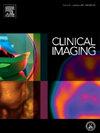基于放射组学的机器学习预测骨肉瘤对新辅助化疗的反应:一项系统综述和荟萃分析
IF 1.5
4区 医学
Q3 RADIOLOGY, NUCLEAR MEDICINE & MEDICAL IMAGING
引用次数: 0
摘要
背景和目的骨肉瘤(OS)是最常见的原发性骨恶性肿瘤,新辅助化疗(NAC)可提高生存率。然而,OS的异质性导致不同的治疗反应,强调需要可靠的、非侵入性的工具来预测NAC反应。基于放射组学的机器学习(ML)为识别成像生物标志物以预测治疗结果提供了潜力。本系统综述和荟萃分析评估了放射组学模型预测OS患者NAC反应的准确性和可靠性。方法系统检索截至2024年11月的PubMed、Embase、Scopus、Web of Science数据库。包括使用基于放射组学的ML预测OS患者NAC反应的研究。使用双变量随机效应模型计算训练和验证队列的合并敏感性、特异性和AUC,并分别分析临床联合模型。使用QUADAS-2工具、放射组学质量评分(RQS)和METRICS评分进行质量评估。结果纳入16项研究,其中MRI占63%,CT占37%。荟萃分析包括12项研究,包括1639名参与者。训练队列的合并指标显示AUC为0.93,敏感性为0.89,特异性为0.85。验证队列的AUC为0.87,灵敏度为0.81,特异性为0.82。临床联合模型优于仅放射组学模型。RQS平均评分为9.44±3.41,METRICS平均评分为60.8%±17.4%。结论基于放射组学的ML预测OS患者NAC反应具有良好前景,特别是与临床指标相结合时。然而,必须解决外部验证和方法一致性方面的限制。本文章由计算机程序翻译,如有差异,请以英文原文为准。
Radiomics-based machine learning in prediction of response to neoadjuvant chemotherapy in osteosarcoma: A systematic review and meta-analysis
Background and aims
Osteosarcoma (OS) is the most common primary bone malignancy, and neoadjuvant chemotherapy (NAC) improves survival rates. However, OS heterogeneity results in variable treatment responses, highlighting the need for reliable, non-invasive tools to predict NAC response. Radiomics-based machine learning (ML) offers potential for identifying imaging biomarkers to predict treatment outcomes. This systematic review and meta-analysis evaluated the accuracy and reliability of radiomics models for predicting NAC response in OS.
Methods
A systematic search was conducted in PubMed, Embase, Scopus, and Web of Science up to November 2024. Studies using radiomics-based ML for NAC response prediction in OS were included. Pooled sensitivity, specificity, and AUC for training and validation cohorts were calculated using bivariate random-effects modeling, with clinical-combined models analyzed separately. Quality assessment was performed using the QUADAS-2 tool, radiomics quality score (RQS), and METRICS scores.
Results
Sixteen studies were included, with 63 % using MRI and 37 % using CT. Twelve studies, comprising 1639 participants, were included in the meta-analysis. Pooled metrics for training cohorts showed an AUC of 0.93, sensitivity of 0.89, and specificity of 0.85. Validation cohorts achieved an AUC of 0.87, sensitivity of 0.81, and specificity of 0.82. Clinical-combined models outperformed radiomics-only models. The mean RQS score was 9.44 ± 3.41, and the mean METRICS score was 60.8 % ± 17.4 %.
Conclusion
Radiomics-based ML shows promise for predicting NAC response in OS, especially when combined with clinical indicators. However, limitations in external validation and methodological consistency must be addressed.
求助全文
通过发布文献求助,成功后即可免费获取论文全文。
去求助
来源期刊

Clinical Imaging
医学-核医学
CiteScore
4.60
自引率
0.00%
发文量
265
审稿时长
35 days
期刊介绍:
The mission of Clinical Imaging is to publish, in a timely manner, the very best radiology research from the United States and around the world with special attention to the impact of medical imaging on patient care. The journal''s publications cover all imaging modalities, radiology issues related to patients, policy and practice improvements, and clinically-oriented imaging physics and informatics. The journal is a valuable resource for practicing radiologists, radiologists-in-training and other clinicians with an interest in imaging. Papers are carefully peer-reviewed and selected by our experienced subject editors who are leading experts spanning the range of imaging sub-specialties, which include:
-Body Imaging-
Breast Imaging-
Cardiothoracic Imaging-
Imaging Physics and Informatics-
Molecular Imaging and Nuclear Medicine-
Musculoskeletal and Emergency Imaging-
Neuroradiology-
Practice, Policy & Education-
Pediatric Imaging-
Vascular and Interventional Radiology
 求助内容:
求助内容: 应助结果提醒方式:
应助结果提醒方式:


